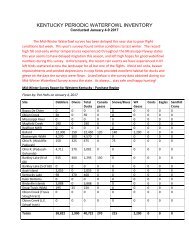Kentucky Fishes
kyfishid[1]
kyfishid[1]
- No tags were found...
Create successful ePaper yourself
Turn your PDF publications into a flip-book with our unique Google optimized e-Paper software.
GOLDEN SHINER<br />
(Notemigonus crysoleucas)<br />
CREEK CHUB<br />
(Semotilus atromaculatus)<br />
Matthew Thomas / Ky. Dept. of Fish & Wildlife Resources<br />
Ç Identification: A large minnow that is deep-bodied and thin from side to side. It<br />
has a small, slightly upturned mouth, a strongly decurved lateral line, and fleshy keel<br />
along the belly. Color is olive-green on the back and silvery to brassy on the sides. The<br />
fins are light olive or yellow. Adults grow to about 12 in.<br />
Distribution and Habitat: Common in sluggish water bodies, including reservoirs,<br />
oxbows, sloughs and lowland streams. The Golden Shiner is most abundant from the<br />
lower Green River westward, but its common use as a bait fish has resulted in numerous<br />
introductions throughout the state.<br />
BLUNTNOSE MINNOW<br />
(Pimephales notatus)<br />
Breeding male<br />
Ç Identification: A large minnow with a dark spot at the front base of the dorsal<br />
fin. Other distinguishing features include a broad head and large mouth that extends<br />
backward to below the front of the eye. Males in breeding condition develop rosy<br />
color along the side, orange on the fins, and large, hooked tubercles on the head.<br />
Adults grow to about 12 in.<br />
Distribution and Habitat: The most common minnow in headwater creeks and small<br />
to medium sized streams across the state. The Creek Chub is able to survive in isolated<br />
pools of small creeks during periods of drought, then repopulate when normal<br />
flows are restored.<br />
Sucker Family (Catostomidae)<br />
Matthew Thomas / Ky. Dept. of Fish & Wildlife Resources<br />
<strong>Kentucky</strong> has 21 species of suckers, including one, the Harelip Sucker, which is now<br />
extinct. Most of these are large fishes that often make up the greatest biomass in<br />
streams and reservoirs throughout the state. As their name implies, suckers are adapted<br />
to feeding on the bottom with their thick fleshy lips. Some of the large river and reservoir<br />
species (e.g., the buffalofishes) are valued by commercial fishermen as food fishes.<br />
Six of the most commonly encountered species are presented below.<br />
Breeding male<br />
Matthew Thomas / Ky. Dept. of Fish & Wildlife Resources<br />
Ç Identification: A small fish with a rounded snout overhanging a small, slightly<br />
downturned mouth. Other distinguishing features include scales on the back that become<br />
small and crowded just behind the head, a black spot at the base of the caudal<br />
fin, and a thin dark stripe down the side of the body. Males in breeding condition<br />
develop a darkly colored head, large tubercles on the snout, and a black spot at the<br />
front of the dorsal fin. Adults grow to about 4.5 in.<br />
Distribution and Habitat: One of the most common and widespread minnows in <strong>Kentucky</strong>.<br />
The Bluntnose Minnow occupies a wide variety of habitats, from small creeks<br />
to large rivers. It generally prefers warm, shallow pools and runs over rocky bottoms.<br />
WHITE SUCKER<br />
(Catostomus commersonii)<br />
Matthew Thomas / Ky. Dept. of Fish & Wildlife Resources<br />
Ç Identification: A slender fish with a cylindrical body and small scales behind the<br />
head that increase in size toward the tail. Color is olive or gray above with white<br />
undersides. Juveniles and immature fish have 3-4 dark blotches on the side. Males in<br />
breeding condition develop a red stripe along the side, and tubercles on the anal and<br />
16 17



